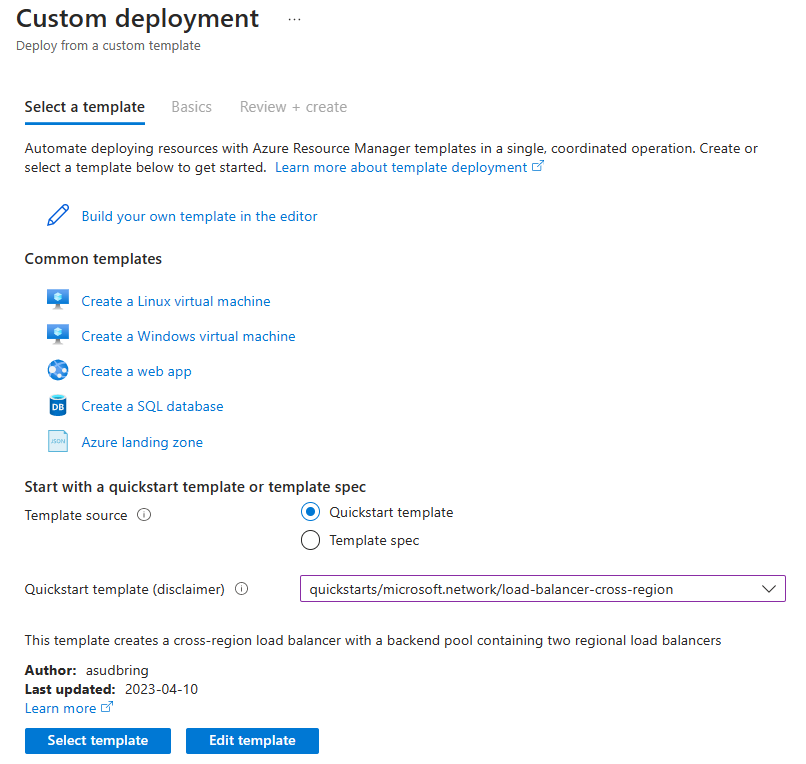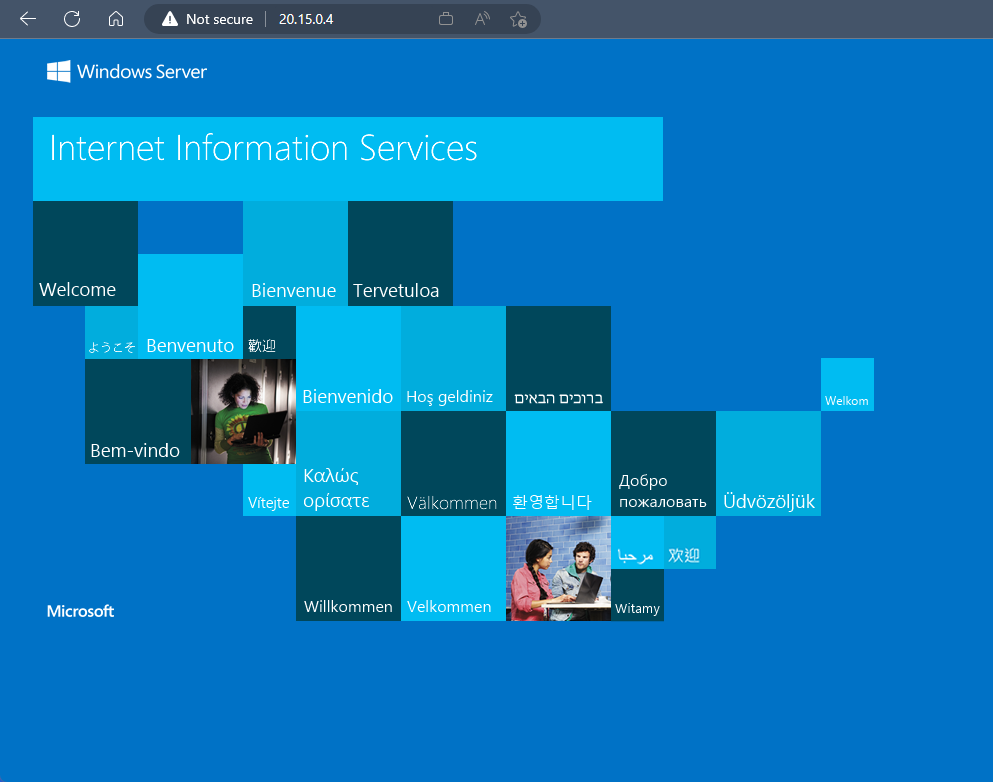Note
Access to this page requires authorization. You can try signing in or changing directories.
Access to this page requires authorization. You can try changing directories.
A global load balancer ensures a service is available globally across multiple Azure regions. If one region fails, the traffic is routed to the next closest healthy regional load balancer.
Using an ARM template takes fewer steps comparing to other deployment methods.
An Azure Resource Manager template is a JavaScript Object Notation (JSON) file that defines the infrastructure and configuration for your project. The template uses declarative syntax. You describe your intended deployment without writing the sequence of programming commands to create the deployment.
If your environment meets the prerequisites and you're familiar with using ARM templates, select the Deploy to Azure button. The template opens in the Azure portal.
In this tutorial, you learn how to:
- All tutorials include a list summarizing the steps to completion
- Each of these bullet points align to a key H2
- Use these green checkboxes in a tutorial
Prerequisites
- An Azure account with an active subscription. Create an account for free and access to the Azure portal.
Review the template
In this section, you review the template and the parameters that are used to deploy the global load balancer. The template used in this quickstart is from the Azure Quickstart Templates.
{
"$schema": "https://schema.management.azure.com/schemas/2019-04-01/deploymentTemplate.json#",
"contentVersion": "1.0.0.0",
"metadata": {
"_generator": {
"name": "bicep",
"version": "0.25.53.49325",
"templateHash": "6587483520975479408"
}
},
"parameters": {
"adminUsername": {
"type": "string",
"metadata": {
"description": "Admin username"
}
},
"adminPassword": {
"type": "securestring",
"metadata": {
"description": "Admin password"
}
},
"vmNamePrefix": {
"type": "string",
"defaultValue": "BackendVM",
"metadata": {
"description": "Prefix to use for VM names"
}
},
"location": {
"type": "string",
"defaultValue": "[resourceGroup().location]",
"metadata": {
"description": "Location for all resources."
}
},
"vmSize": {
"type": "string",
"defaultValue": "Standard_D2s_v3",
"metadata": {
"description": "Size of the virtual machines"
}
}
},
"variables": {
"availabilitySetName": "AvSet",
"storageAccountType": "Standard_LRS",
"storageAccountName": "[uniqueString(resourceGroup().id)]",
"virtualNetworkName": "vNet",
"subnetName": "backendSubnet",
"loadBalancerName": "ilb",
"networkInterfaceName": "nic",
"subnetRef": "[resourceId('Microsoft.Network/virtualNetworks/subnets', variables('virtualNetworkName'), variables('subnetName'))]",
"numberOfInstances": 2
},
"resources": [
{
"type": "Microsoft.Storage/storageAccounts",
"apiVersion": "2023-01-01",
"name": "[variables('storageAccountName')]",
"location": "[parameters('location')]",
"sku": {
"name": "[variables('storageAccountType')]"
},
"kind": "StorageV2"
},
{
"type": "Microsoft.Compute/availabilitySets",
"apiVersion": "2023-09-01",
"name": "[variables('availabilitySetName')]",
"location": "[parameters('location')]",
"sku": {
"name": "Aligned"
},
"properties": {
"platformUpdateDomainCount": 2,
"platformFaultDomainCount": 2
}
},
{
"type": "Microsoft.Network/virtualNetworks",
"apiVersion": "2023-09-01",
"name": "[variables('virtualNetworkName')]",
"location": "[parameters('location')]",
"properties": {
"addressSpace": {
"addressPrefixes": [
"10.0.0.0/16"
]
},
"subnets": [
{
"name": "[variables('subnetName')]",
"properties": {
"addressPrefix": "10.0.2.0/24"
}
}
]
}
},
{
"copy": {
"name": "networkInterface",
"count": "[length(range(0, variables('numberOfInstances')))]"
},
"type": "Microsoft.Network/networkInterfaces",
"apiVersion": "2023-09-01",
"name": "[format('{0}{1}', variables('networkInterfaceName'), range(0, variables('numberOfInstances'))[copyIndex()])]",
"location": "[parameters('location')]",
"properties": {
"ipConfigurations": [
{
"name": "ipconfig1",
"properties": {
"privateIPAllocationMethod": "Dynamic",
"subnet": {
"id": "[variables('subnetRef')]"
},
"loadBalancerBackendAddressPools": [
{
"id": "[resourceId('Microsoft.Network/loadBalancers/backendAddressPools', variables('loadBalancerName'), 'BackendPool1')]"
}
]
}
}
]
},
"dependsOn": [
"[resourceId('Microsoft.Network/loadBalancers', variables('loadBalancerName'))]",
"[resourceId('Microsoft.Network/virtualNetworks', variables('virtualNetworkName'))]"
]
},
{
"type": "Microsoft.Network/loadBalancers",
"apiVersion": "2023-09-01",
"name": "[variables('loadBalancerName')]",
"location": "[parameters('location')]",
"sku": {
"name": "Standard"
},
"properties": {
"frontendIPConfigurations": [
{
"properties": {
"subnet": {
"id": "[variables('subnetRef')]"
},
"privateIPAddress": "10.0.2.6",
"privateIPAllocationMethod": "Static"
},
"name": "LoadBalancerFrontend"
}
],
"backendAddressPools": [
{
"name": "BackendPool1"
}
],
"loadBalancingRules": [
{
"properties": {
"frontendIPConfiguration": {
"id": "[resourceId('Microsoft.Network/loadBalancers/frontendIpConfigurations', variables('loadBalancerName'), 'LoadBalancerFrontend')]"
},
"backendAddressPool": {
"id": "[resourceId('Microsoft.Network/loadBalancers/backendAddressPools', variables('loadBalancerName'), 'BackendPool1')]"
},
"probe": {
"id": "[resourceId('Microsoft.Network/loadBalancers/probes', variables('loadBalancerName'), 'lbprobe')]"
},
"protocol": "Tcp",
"frontendPort": 80,
"backendPort": 80,
"idleTimeoutInMinutes": 15
},
"name": "lbrule"
}
],
"probes": [
{
"properties": {
"protocol": "Tcp",
"port": 80,
"intervalInSeconds": 15,
"numberOfProbes": 2
},
"name": "lbprobe"
}
]
},
"dependsOn": [
"[resourceId('Microsoft.Network/virtualNetworks', variables('virtualNetworkName'))]"
]
},
{
"copy": {
"name": "vm",
"count": "[length(range(0, variables('numberOfInstances')))]"
},
"type": "Microsoft.Compute/virtualMachines",
"apiVersion": "2023-09-01",
"name": "[format('{0}{1}', parameters('vmNamePrefix'), range(0, variables('numberOfInstances'))[copyIndex()])]",
"location": "[parameters('location')]",
"properties": {
"availabilitySet": {
"id": "[resourceId('Microsoft.Compute/availabilitySets', variables('availabilitySetName'))]"
},
"hardwareProfile": {
"vmSize": "[parameters('vmSize')]"
},
"osProfile": {
"computerName": "[format('{0}{1}', parameters('vmNamePrefix'), range(0, variables('numberOfInstances'))[copyIndex()])]",
"adminUsername": "[parameters('adminUsername')]",
"adminPassword": "[parameters('adminPassword')]"
},
"storageProfile": {
"imageReference": {
"publisher": "MicrosoftWindowsServer",
"offer": "WindowsServer",
"sku": "2019-Datacenter",
"version": "latest"
},
"osDisk": {
"createOption": "FromImage"
}
},
"networkProfile": {
"networkInterfaces": [
{
"id": "[resourceId('Microsoft.Network/networkInterfaces', format('{0}{1}', variables('networkInterfaceName'), range(0, variables('numberOfInstances'))[range(0, variables('numberOfInstances'))[copyIndex()]]))]"
}
]
},
"diagnosticsProfile": {
"bootDiagnostics": {
"enabled": true,
"storageUri": "[reference(resourceId('Microsoft.Storage/storageAccounts', variables('storageAccountName')), '2023-01-01').primaryEndpoints.blob]"
}
}
},
"dependsOn": [
"[resourceId('Microsoft.Compute/availabilitySets', variables('availabilitySetName'))]",
"[resourceId('Microsoft.Network/networkInterfaces', format('{0}{1}', variables('networkInterfaceName'), range(0, variables('numberOfInstances'))[range(0, variables('numberOfInstances'))[copyIndex()]]))]",
"[resourceId('Microsoft.Storage/storageAccounts', variables('storageAccountName'))]"
]
}
],
"outputs": {
"location": {
"type": "string",
"value": "[parameters('location')]"
},
"name": {
"type": "string",
"value": "[variables('loadBalancerName')]"
},
"resourceGroupName": {
"type": "string",
"value": "[resourceGroup().name]"
},
"resourceId": {
"type": "string",
"value": "[resourceId('Microsoft.Network/loadBalancers', variables('loadBalancerName'))]"
}
}
}
Note
When you create a standard load balancer, you must also create a new standard public IP address that is configured as the frontend for the standard load balancer. Also, the Load balancers and public IP SKUs must match. In our case, we will create two standard public IP addresses, one for the regional level load balancer and another for the global load balancer.
Multiple Azure resources have been defined in the template:
Microsoft.Network/loadBalancers:Regional and global load balancers.
Microsoft.Network/publicIPAddresses: for the load balancer, bastion host, and for each of the virtual machines.
Microsoft.Network/virtualNetworks: Virtual network for load balancer and virtual machines.
Microsoft.Compute/virtualMachines (2): Virtual machines.
Microsoft.Network/networkInterfaces (2): Network interfaces for virtual machines.
Microsoft.Compute/virtualMachine/extensions (2): use to configure the Internet Information Server (IIS), and the web pages.
Important
Hourly pricing starts from the moment that Bastion is deployed, regardless of outbound data usage. For more information, see Pricing and SKUs. If you're deploying Bastion as part of a tutorial or test, we recommend that you delete this resource after you finish using it.
To find more templates that are related to Azure Load Balancer, see Azure Quickstart Templates.
Deploy the template
Sign in to the Azure portal.
Enter and select Deploy a custom template in the search bar
In the Custom deployment page, enter load-balancer-cross-region in the Quickstart template textbox and select quickstarts/microsoft.network/load-balancer-cross-region.

Choose Select template and enter the following information:
Name Value Subscription Select your subscription Resource group Select your resource group or create a new resource group Region Select the deployment region for resources Project Name Enter a project name used to create unique resource names LocationCR Select the deployment region for the cross-region load balancer Location-r1 Select the deployment region for the regional load balancer and VMs Location-r2 Select the deployment region where the regional load balancer and VMs Admin Username Enter a username for the virtual machines Admin Password Enter a password for the virtual machines Select Review + create to run template validation.
If no errors are present, Review the terms of the template and select Create.
Verify the deployment
If necessary, sign in to the Azure portal.
Select Resource groups from the left pane.
Select the resource group used in the deployment. The default resource group name is the project name with -rg appended. For example, crlb-learn-arm-rg.
Select the global load balancer. Its default name is the project name with -cr appended. For example, crlb-learn-arm-cr.
Copy only the IP address part of the public IP address, and then paste it into the address bar of your browser. The page resolves to a default IIS Windows Server web page.

Clean up resources
When you no longer need them, delete the:
- Resource group
- Load balancer
- Related resources
- Go to the Azure portal, select the resource group that contains the load balancer, and then select Delete resource group.
- Select apply force delete for selected Virtual machines and Virtual machine scale sets, enter the name of the resource group, and then select **Delete > Delete **.
Next steps
In this tutorial, you:
- Created a cross region load balancer\
- Created a regional load balancer
- Created three virtual machines and linked them to the regional load balancer
- Configured the global load balancer to work with the regional load balancer
- Tested the global load balancer.
Learn more about cross-region load balancer.
Advance to the next article to learn how to create...
